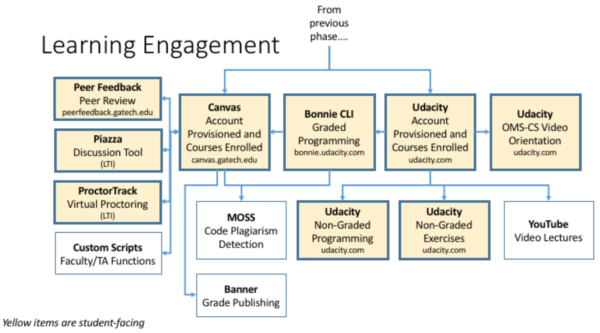Published on
Towards An Ecosystem of Platforms: The Critical Importance of Interoperability

When a new online degree program is announced in the press, the program title is followed by a platform partnership. We often hear about Georgia Tech’s Online Master of Science in Computer Science (OMSCS) “on Udacity” or “on edX.” It is usually an over-simplification; each program makes use of multiple learning platforms.
Georgia Tech recently conducted an analysis of all of the platforms, processes and systems employed in our OMSCS program. The goal was to get a 30,000-foot view of the entire student lifecycle, and to identify all of the online destinations that students interact with throughout the program. While it can be difficult to conduct an analysis of this type at 100 percent accuracy, the attempt to do so can be revealing.
Although our analysis looked at every phase throughout the OMSCS student lifecycle, let’s focus on a single phase: Learning Engagement. This is the phase that includes all of the activities that happen within a single course. Each yellow box represents a component that is student facing. They may be platforms, plugins, tools or simply processes that are visible to the student in some way. The analysis of the OMSCS Engagement phase can be seen below:
Right away, you will notice that a typical OMSCS course might direct students to Udacity (a Massive Open Online Learning, MOOC, platform), Canvas (Georgia Tech’s learning management system), Bonnie (a programming assignment autograder), Peer Feedback (a peer review tool) or Piazza (a discussion forum).
So, when we talk about platforms for online learning at scale, we’re talking about multiple platforms—several of which have multiple layers of technologies or tools stacked atop them.
Platforms’ Three Functional Areas
Why are we piecing together so many disparate platforms? Online learning platforms are typically technologies that are trying to perform three broad functions:
- Content and Activity Management (CAM): The platform allows for student-content interaction through creation and delivery of content pages, lessons, multimedia assets such as videos, and assignments and exams.
- Engagement Management (EM): The platform allows for student-faculty and student-student interaction through messaging, discussion boards, chats and web conferencing.
- Learning Management (LM): The platform enables the management of rosters, grades, attendance, outcomes reporting and analytics.
The reality is, no platform excels in all three. MOOC platforms may often be really strong in CAM, allowing an instructional team to easily lay out a series of videos or quizzes into a pleasant experience for learners. However, they typically suffer from weak capabilities in EM or LM—lacking full-featured private messaging or discussion boards, synchronous interaction capabilities, gradebooks or enrollment mechanisms. Platforms that are strong in LM sometimes leave room for improvement as CAM or EM platforms.
A Single Platform?
Should we strive to combine all of these functions into a single platform? There would certainly be a variety of benefits in doing so, including, but not limited to:
- Streamlined user experience for learners
- Easier data extraction, ingestion and analysis for generating insights for administrators, faculty and students
- Simpler support services
- Fewer data security concerns
- Ease of procurement
Whether we pursue a single platform or not, we should work towards all of these goals. However, over the course of the past six years in the MOOC space and over 40 years of delivering learning from a distance at Georgia Tech, our work with multiple platforms leads us to believe that no single platform can (or should) do it all. Three developments have led us to this conclusion:
- Platforms’ Pedagogical Approaches
- The Emergence of Platform Interoperability
- Institutional Need to Minimize Risk
In the following sections, we will expand on each of these to make the argument that forward-looking educators should anticipate using more learning platforms, not fewer.
Platforms’ Pedagogical Approaches
Most learning platforms would hesitate to admit it, but they generally focus on a specific pedagogical approach. For example, most MOOC platforms prioritize video content. While they all offer a variety of tools for assessment, collaboration and more, video is king in MOOC platforms.
On the other hand, adaptive platforms focus primarily on personalized learning paths and custom feedback. Learning management system (LMS) platforms focus on simplifying administrative tasks for instructors, freeing them to be more effective educators. Discussion platforms focus on peer-based learning, and allow instructors to facilitate learning communities. Most successful educational technology companies’ product teams will initially subscribe to a single pedagogical approach and build their learning platform accordingly.
Most academic programs—whether they’re public MOOCs, online for-credit courses, in-person classes or blended learning—cannot subscribe to a single pedagogical approach. A single, well-designed class might (and should) leverage video animations, formative assessments, adaptive feedback, project-based learning, peer teaching and more. No single platform is likely to effectively support such a diverse array of learning strategies.
The Emergence of Platform Interoperability
Educators’ time is better spent pushing our existing platforms to adhere to interoperability standards, rather than pushing them to excel in all functional areas and pedagogical approaches. The former would allow us to tightly integrate multiple platforms that are particularly strong in specific ways. The latter risks a platform being mediocre in all areas and exceptional in none.
Recently, we, at Georgia Tech, started referring to this idea as the Scalable Advanced Learning Ecosystem (SALE), which can be construed as an extension of the term Next Generation Digital Learning Environment (NGDLE). In either case, it would look very much like the OMSCS diagram from above. However, for an SALE/NGDLE to be effective, it should:
- Make it easy to ingest data from all platforms by adhering to standards like Caliper or xAPI.
- Allow content to be easily transportable between platforms using Common Cartridge or SCORM.
- Enable instructional teams to expand functionality and tighten integrations using LTI or open APIs.
- Enable personalized learning through a highly flexible framework that encourages instructors to mix-and-match or plug-and-play components.
In fact, some of the latest developments from IMS Global Learning Consortium are bringing the SALE/NGDLE even closer to reality.
- LTI Advantage builds on the existing LTI standard to allow even deeper integration of learning tools with learning management systems.
- LTI Insights leverages the Caliper standard to provide data to institutions about the usage of all of the learning tools integrated into their learning ecosystem.
- Comprehensive Learning Record provides secure verifiable digital records for learners’ variety of educational experiences, including courses, competencies, skills, co-curricular achievements, prior learning, internships and experiential learning.
- Edu-API is a set of APIs to support the exchange of data between transactional systems (e.g. student information systems) and teaching and learning platforms (e.g. learning management systems).
This concept is not unique to learning platforms. Most health organizations use specialized Electronic Health Record (EHS) systems that meet their unique needs. However, patients must navigate from one provider to another, and organizations need to be able to easily share health records with other providers. Experts in governmental systems, social media, supply chain and logistics, and other fields are all having similar conversations around platform interoperability.
Institutional Need to Minimize Risk
Finally, any online learning program needs to consider ways to mitigate risk. What happens when a platform partner or technology disappears or becomes obsolete? If a single platform is in use, the entirelearning ecosystem would need to be replaced. If a diverse set of tightly integrated platforms is in use, the institution would have expertise and know-how in a variety of platforms and a single component could be swapped out.
Take Georgia Tech’s recent experience with our campus learning management system as an example. In the diagram above, we explain that OMSCS uses Canvas for administrative functions, including gradebooks, rosters and attendance. Just over a year ago, we were using T-Square (Georgia Tech’s Sakai implementation) for these purposes. In 2016, the institution decided that it was time to evaluate potential replacements for T-Square. After a lengthy evaluation process, Canvas was identified as the preferred alternative and the migration from T-Square to Canvas began. Imagine if—at the time of this transition—OMSCS courses were using T-Square for everything (video delivery, discussions, programming assignments, peer feedback and all other class activities). The switch from T-Square to Canvas would have been much more difficult and time-consuming, likely causing severe disruptions to the OMSCS program.
As Platform Convergence Dwindles
As professionals in the broader academic technology space, we feel platform fatigue due to the many technology players and their offerings. Secretly (or openly), we wish for a day of platform convergence. We are convinced that it will be a harder future to imagine and more importantly, it may not be the most advantageous approach to creating the most effective learning environment for our students. We reiterate and remind the importance of interoperability to our technology providers and ask them to prioritize this over adding new features and functionalities to their platforms.
Author Perspective: Administrator



